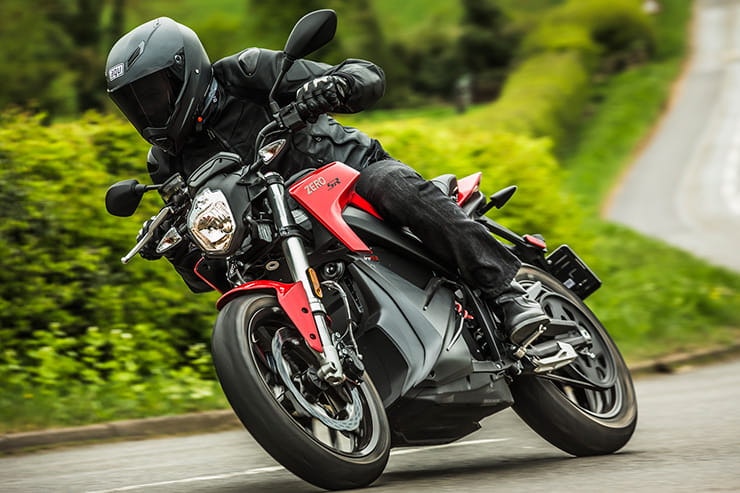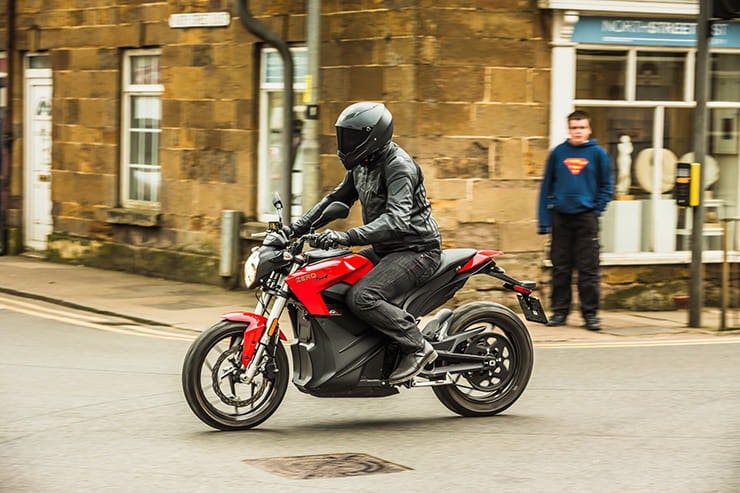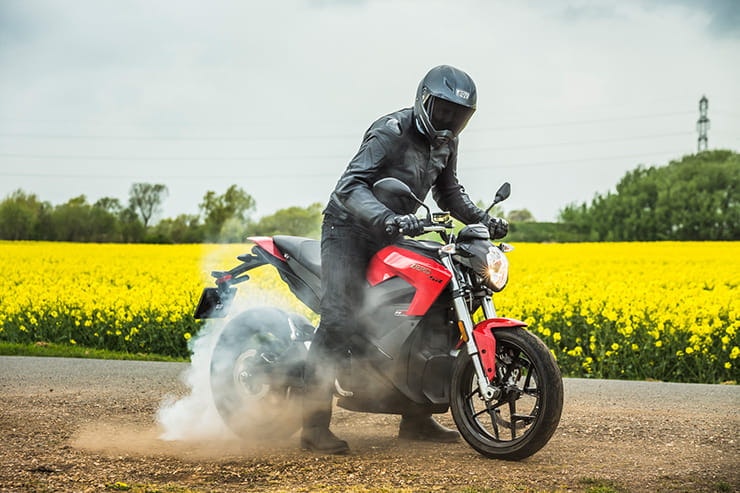Zero SR (2017) - Review | Electric Dreams
By Michael Mann
BikeSocial Managing Editor
24.05.2017
KIT CREDITS
BOOTS
Dainese S. Germain Gore-Tex - £169.95
Question: which bike weighs less than a Suzuki SV650, has more torque than a BMW S1000RR, almost as much as a Huyabusa, and can be powered with a kettle lead?
Answer? Well it’s fairly obvious if you’ve seen the headline of this review. But, a Zero SR is the answer we were looking for. All £15,690 of it.
The Californian manufacturer has a range of six models, all updated for 2017 and all of which can all be ridden on a standard A2 motorcycle licence, including the sportier SR and DSR.
The British Government’s Office for Low Emission Vehicles (OLEV) will even pay you £1500 to ride one such is their optimism and commitment towards a cleaner, healthier ozone.
But wait. Just because it’s electric doesn’t mean you have permission to turn away now. Read on, it’s good. The bike that is, not necessarily this drivel. The Zero SR is a glimpse into the future of motorcycling, at this stage maybe just a step into that direction instead of an entire game-changing leap, like it or not. Here’s a bike that will beat a Yamaha MT-07 to 30mph, will do 0-60mph in 3.8s and is less than 0.5s off a GSX-R1000R in a 40-90mph roll-on competition, it creates no pollution and requires nothing but a regular house-hold socket costing around £2.30 instead of £15 worth of fuel every 100 miles.
I know that’s an awful lot of £12.70 savings per tank/charge before you break even with a fifteen-and-a-bit grand investment versus, let’s say, the £6099 MT-07.
Can the Zero be a Hero?
BikeSocial's Michael Mann sees how far a full tank gets him in normal road riding conditions.
Let me guess what your immediate questions are;
how far does it go for £2.30, mate?
Yeah, but how long does it take charge?
Well, from 0% and completely empty to 100% full takes just under a yawn-inspiring 9 hours – the digital display even shows a timer until full. Ride it properly and there’s a fair chance you won’t ever run out. I mean, how many times does you mobile run dry? With my ‘phone, if I get to the end of the day with something like 30-40% remaining, I plug it in out of habit and it’s full and good to go the next morning. There’s no reason why electric bike owners of now or in the future wouldn’t get into the same habits.
Twenty-five years ago, mobile phones were the size and weight of house bricks. Who’d have thought back then that a mobile phone could one day have more processing power than a 90s Dell? Not only has the technology taken significant leaps and bounds over the last two decades but so has our daily management in terms of making sure the battery is at its optimum. We charge them mainly at our convenience and that’s how we will look at battery-powered motorcycles…one day. Right now, so long as B isn’t more than about 100 miles from A then all is well, until you need to get back to A again.
By the way, having said all of that, for an extra £702 the optional fast charger will cut charge time in half.
For the first thirty miles of my Zero SR viginity-breaking ride, my attention was certainly drawn towards the battery indicator rather than either the speedo or sometimes the road. Convinced I was going to run out in the middle of nowhere, my inexperience of electric motorcycle riding and stigma around the battery life suddenly giving up was showing. You know how your mobile says 15% then about two minutes later it’s down to 6%, dropping in power unpredictably. That’s what I had in my mind for the Zero. Was the battery life going to suddenly disappear?
That said, I wasn’t a complete virgin. I’ve ridden the Brammo Empulse with its completely irrelevant gearbox as well as a prototype of the high spec sports bike from Energica called the ‘Ego’, albeit a couple of years back. The Zero SR is a different kettle of fish though. It’s quality components are strapped to a very rider friendly chassis and come to together to create a comfortable and usable bike. Plus, at 188kg, it’s a lot lighter than either the Energica or Brammo and significantly more noticeable when in the twisty bits or manoeuvring the bike in a car park, for example.
As the miles passed I became more at ease with the diminishing battery reserves, knowing that I wasn’t going to be riding 100+ of them and I also knew that at my destination there’d be a socket. They’re fairly common in the UK after all! The charge lead was with me, sitting in the compartment formally known as the fuel tank (a la Honda NC750X). So, with Sport mode engaged and throttle pinned, the tingly feeling inside emerged as the massive torque-laden boost of acceleration defied the bikes’ middleweight naked appearance. Especially when you look at that skinny rear Pirelli, it’s a wonder how the SR’s 107.7 ft-lbs of torque, which incidentally is more than any 1000cc production sports bike, keeps traction. Sometimes when encouraged not to, it doesn’t…whoops! A burnout now sounds like a trip to the dentist with the high-pitched buzz of the SR’s motor reminiscent of the tooth man’s drill.
Ride it sensibly and the noise is more milk float than Akrapovic. A soft whine, whirring like a turbine from 0mph that increases in tempo and volume until the wind and road noise interject.
The infrastructure in the UK doesn’t seem to be in place just yet, you can’t just turn up to a café, dealership, mates house or the office and plug it in for the equivalent time it normally takes to refuel and off you trot with a complete top-up. Interchangeable battery packs would be the most obvious Dragon’s Den-style creation but that would take significant world-wide investment; pull into the garage and it’s out with the old and in with the new battery and off you trot.
With electrically powered vehicles becoming more prominent the country’s vehicle charging arrangements will have to develop. Alternative power is the future and will replace combustible fuel one day but for now Zero are claiming a range of 100 miles from a 100% battery on this SR model and that’s with ‘normal’ riding using a combination of Eco and Sport mode. The third mode, known as Custom, is operated via the bespoke app. In Eco mode, speed is limited to 70mph and torque is cut by 50-60%. The power input is gentle and if you ride around like you’re Driving Miss Daisy then of course you’ll get a bigger range but you’ll end up feeling miserable and bored unless a city-centre commute is your only trip. In a true Tortoise vs Hare scenario, flick into Sport and ride like a hooligan, range will be sacrificed and replaced by that tingly feeling.
What’s the range?
So, here’s the challenge; under ‘normal’ riding conditions how far can I go with one full battery before it stops with nothing left in the tank? I wasn’t prepared to ride around just in Eco mode all day nor was I going to rock Sport mode and pin the throttle every chance I got.
Heading from BikeSocial’s Peterborough-based office, it was a short trip along the A47 in Eco mode to the local Ducati dealership at Wansford, a mere 6.5 miles away. Or, in battery-speak that’ll be 9%. Interestingly by the time I came to leave the dealership, the battery was showing 93% remaining.
At Ducati we bump into a customer, Stuart Green, who’d brought his Multistrada S in for a tyre change. The Multistrada S is priced at £15,895, that’s just £205 more than the Zero.
As the Ducati sales and servicing team flock to see the Zero (and mop up some escaping brake fluid, thanks v much!), Mr Green pretty much confirmed he won’t be swapping his bike for a battery-powered version anytime soon though. He told me, “I’ve not ridden any electric bikes, I’ve seen a few at the bike shows but to be honest I’ve not taken much notice. I’m not really interested in electric cars either, maybe because it’s too new. There’s not many charging places so you get caught out with a bike you could be stuck.”
A sentiment seemingly shared by many who have yet to spend a week with an electric vehicle.
Moving on and our proposed route of 60.4 miles plus an extra 10 for photos and video purposes at three stops along the route, was already looking in trouble as we arrived at the Sycamore Harley-Davidson dealership in Uppingham. We found some sweet little B-roads along the way for a photo stop and after 34 miles just 50% battery remained. The B-road section was not conducive for economic riding though as backwards and forwards half-a-dozen times over a mile-long stretch I rode. It was time to turn on Sensible mode.
But before that, parked outside the HD dealership, a Forty-Eight next to me rumbles into life before the humungous clunk of first gear being engaged spoke volumes as it vibrates and wobbles away next to the Zero. The generation gap is almost tangible. Harley of course hit the headlines in June 2014 when they unveiled a concept electric bike of their own known as ‘Project Livewire’, telling us more recently they’d be selling electric bikes by 2021.
For now, the salesman tells me the nearest Harley cost-wise is a Softail Slim at £15,995. Talk about polar opposites.
The concern was that with just 50% battery remaining we’d have to skip our milkshake stop in Market Deeping the American-style, motorcycle-very friendly Iron Horse Ranch House and instead head straight to the Wheels dealership back in Peterborough via a couple of photo stops to demonstrate a bit of urban riding.
Around the town and city settings of Uppingham town and Peterborough, pedestrians stare and children point as a silent motorcycle passes by. Drivers double-take as I pass them stealthily and, although a concern shared initially by me and many others, not one person stepped out into the road because they didn’t hear me.
Wheels sell Kawasaki, Suzuki, Piaggio and Honda – there’s a café and plenty of parking so no matter what time of day there’s usually at least a handful of motorcyclists gathered. Ideal to canvass more opinion. As I arrived with just 7% battery remaining (an indicated 12 miles), having covered 66 so far, Mark, Mike and Mish asked if I’d stalled it or just coasted in with the engine off before realising it was electric. The trio were certainly intrigued by the new machine so much so that I expect they’ll be searching for a test ride soon.
Another chap wondered over and distributed his opinion; “Charging a motorbike up just isn’t for me and most motorcyclists are traditional and don’t embrace new technology that well. I understand why it’s happening but it’s still tomorrow’s world not today. Maybe people would pay more attention if it said Suzuki or Kawasaki down the side.”
There’s 12 miles left in ‘the tank’ and a change of plan means the Zero and I are homeward-bound, 7.5 miles away. Jason the photographer had seen a beautiful oil seed rape field and fancied a snap “only a short detour off route”, he assures me. Would this mean I’ll be pushing the bike home just to get the final shot?
This was squeaky bum time.
By the time I coasted into my driveway the display showed 0% but the remaining mileage told me I had 1.8 miles left.
I’d set out to ride the 69bhp Zero SR like I would a normal combustion-engine bike with a bit of sensible stuff mixed in with the style of riding that makes me interested in motorcycling…I wasn’t going to sit in ECO mode all day to max out the range because that’s not how I enjoy riding. Bottom line it’s going to get to less than 80 miles per full charge but there are thirsty sports bikes out there that have a similar range – the Zero SR is more suited to town riding and commuting with the occasional blast around the twisty bits with the convenience of being able to plug it in pretty much wherever you end up for a top up.
It’s upright, comfortable and roomy in the saddle with a ride height that won’t have you scraping the pegs and a favourable riding position. Because the battery is mounted so low in the aluminium twin spar frame, the centre of gravity is equally as low and it keeps the SR stable and nicely balanced at walking speed. Unfortunately, the turning circle isn’t complimentary of this low speed agility. And, while thankfully the Showa suspension is adjustable, in standard settings it’s pretty solid over the hideous Fenland bumps.
Cornering on the SR is a new-fangled thing too, requiring a recalibration of your brain. I’ve realised how helpful revs and engine noise are. Zero claim the powerful, compact, brushless and sealed air-cooled motor is the industry’s most efficient, what I claim is that the engine ‘braking’, or regeneration in electric speak, as well as deceleration is a lot higher in Eco mode than in Sport. Certainly off-throttle cornering requires a little practice to master but there’s potential to carry a lot more corner speed with the fast-turning front end plus stable power and drive train balancing the bike nicely.
Riding the bike is an absolute cinch. Ignition on, sidestand up and away you go; not on the first roll of the throttle through just in case you’ve not realised the bike is ‘live’. The throttle response is instant and smoothly progressive. Eco mode needs a bit of encouragement but Sport is very dynamic. Meanwhile, Custom mode is operable and customisable via the App which also offers information such as battery range.
For a motorcycle that’s priced at £15,690 plus the extra £702 fast charger and not forgetting the optional power tank for £2,600 that increases range by approximately 30% as well as the battery’s life, even with the Government grant it’s still a massive initial outlay. It might be cheap to run once owned but that initial investment could prove to be a big step that prevents the Zero SR from being a massive success and the bike that takes us into tomorrow’s world.
I’m all for a greener future, saving some trees and generally feeling happy about my contribution to an overall less grotty air quality. If it means plugging a bike in at the end of a ride/day then so be it. I’m not sold enough to part with actual money to do so because I believe the state of electric motorcycling, and particularly this Zero SR, firmly points towards city riding and the shorter journey. As a second bike acting as a commuter bike, there’s few better but the Sunday mile-munchers aren’t for turning. There’s definite intrigue among those canvassed on my week with the SR, enough to warrant a test ride in some cases. Give it a go before you judge.
TECHNICAL SPECIFICATIONS
Photos: Jason Critchell
Video: Lee Pincher @ Pix-L Media
Share on social media:


